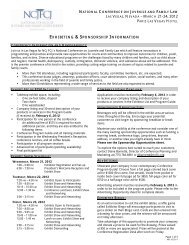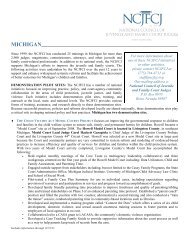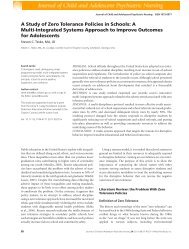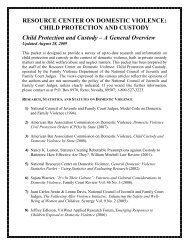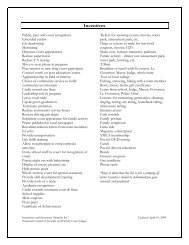The Marijuana Detection Window - National Drug Court Institute
The Marijuana Detection Window - National Drug Court Institute
The Marijuana Detection Window - National Drug Court Institute
- No tags were found...
Create successful ePaper yourself
Turn your PDF publications into a flip-book with our unique Google optimized e-Paper software.
DRUG COURT PRACTITIONER FACT SHEET13 days (range 5-19 days) (1984). Johanssonand Halldin identified only one study subjectthat tested positive for longer than 14 dayswith all thirteen subjects having an averagelast day with detectable levels (using a 20ng/mL cutoff) of 9.8 days (1989). In otherwords, despite the potential factors restrictinginterpretation, those study subjects withexceptionally long cannabinoid detection times(30-plus days) were just that—exceptional.In several of the studies presented in Table 1,only a single subject was the source of themaximum cannabinoid detection time.Unfortunately, these rare occurrences havehad a disproportional influence on the overallcannabinoid detection window discussion ina manner that has led to the general assumptionthat 30-plus day detection times areroutine in drug court clients—regardless ofuse patterns (chronic vs. acute). Moreover,this prolonged elimination assumption andits widespread use as exculpatory evidencehas most likely fostered client denial andhindered legitimate sanctioning efforts.By contrast, the research associated with acutemarijuana usage and resulting cannabinoiddetection window is considerably morestraightforward and less contentious. In a 1995study using six healthy males (under continuousmedical supervision), Huestis, Mitchell,& Cone determined that the mean detectiontimes following a low dose marijuana cigaretteranged from 1 to 5 days and after a high dosecigarette from 3 to 6 days at a 20 ng/mLimmunoassay cutoff concentration (average2.1 days and 3.8 days, respectively) (1995).<strong>The</strong>y also concluded that immunoassays atthe 50 ng/mL cannabinoid cutoff provide onlya narrow window of detection of 1-2 daysfollowing single-event use. In 1996, Huestiset. al. published research focusing on carboxy-THC, the cannabinoid metabolite most oftenidentified by gas chromatography/massspectrometry (GC/MS) confirmation methods.Using the 15 ng/mL GC/MS cutoff, the detectiontime for the last positive urine sample(for six subjects following high dose smoking)was 122 hours—just over five days. In 2001,Niedbala et. al. demonstrated similar resultswith 18 healthy male subjects following thesmoking of cigarettes containing an averageTHC content of 20-25 mg. Analyzing urinesamples at a 50 ng/mL immunoassay cutoffyielded an average cannabinoid detectiontime of 42 hours. <strong>The</strong>se acute marijuanaelimination studies conclude that after singleusage events cannabinoids are detected inurine for no more than a few days.While studies of the cannabinoid detectionwindow in chronic substance users havebeen more difficult to accomplish, researchprotocols have been developed to overcomeconcerns about marijuana usage during thestudy. Using a well-crafted study design,Kouri, Pope, & Lukas in 1999 determined thecannabinoid elimination profiles of 17 chronicusers. Subjects were selected after reportinga history of at least 5000 separate “episodes”of marijuana use in their lifetime (the equivalentof smoking once per day for 13.7 years)plus continuing daily usage. Abstinence duringthe 28-day study was ensured by withdrawingthose subjects whose normalized urinecannabinoid levels (cannabinoid/creatinineratio) indicated evidence of new marijuana use.Kouri, et al, found that five of the 17 subjectsreached non-detectable levels (less than 20ng/mL) within the first week of abstinence,four during the second week, two during thethird week and the remaining six subjectsstill had detectable cannabinoid urinary levelsat the end of the 28-day abstinence period.Unfortunately, analytical results related to thecannabinoid testing in the article were scantas the primary objective of the study was toassess changes in aggressive behavior duringwithdrawal from long-term marijuana use.Even though this represents one of the beststudies of chronic marijuana users, interpretationof this data for cannabinoid eliminationpurposes is limited because the actual drugtesting data is not available. Nonetheless,Kouri, et al, shows that after at least 5000marijuana smoking episodes, 30-day eliminationtimes are possible.7




